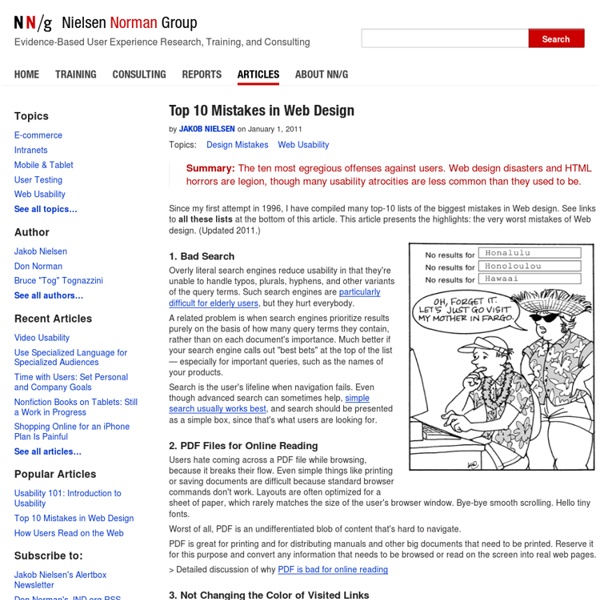



http://www.nngroup.com/articles/top-10-mistakes-web-design/
The Principles of Design The web professional's online magazine of choice. In: Columns > Design in Theory and Practice By Joshua David McClurg-Genevese Published on June 13, 2005 Viewable with Any Browser: Accessible Site Design Guide Below are some useful tips and links that can help to make your site accessible by all browsers, and better in general. This is not meant to be a complete guide to HTML, just a look at web design from an accessibility point of view. I have tried whenever possible to provide links to sites with more indepth information than what is here- please let me know of any sites that would enhance the usefulness of any of the sections below, or if I have missed any important topics in accessibility. Remember when reading this page that the advice provided is as general and thorough as possible to make it the most useful to the most readers. When enhancing the accesibility of your site, make sure to consider any special needs of your site, as well as the intended audience and available time and skill. The more you do to make your site accessible, the better, but if you can't follow all the recommendations, at least do what you can to follow those that make sense to your needs.
Life With Alacrity: The Dunbar Number as a Lately I've been noticing the spread of a meme regarding "Dunbar's Number" of 150 that I believe is misunderstanding of his ideas. The Science of Dunbar's Number Dunbar is an anthropologist at the University College of London, who wrote a paper on Co-Evolution Of Neocortex Size, Group Size And Language In Humans where he hypothesizes: ... there is a cognitive limit to the number of individuals with whom any one person can maintain stable relationships, that this limit is a direct function of relative neocortex size, and that this in turn limits group size ... the limit imposed by neocortical processing capacity is simply on the number of individuals with whom a stable inter-personal relationship can be maintained. Dunbar supports this hypothesis through studies by a number of field anthropologists.
Alertbox: Jakob Nielsen's Newsletter on Web Usability 10 Usability Heuristics for User Interface Design April 24, 1994 | Article: 2 minutes to readJakob Nielsen's 10 general principles for interaction design. They are called "heuristics" because they are broad rules of thumb and not specific usability guidelines. When to Use Which User-Experience Research Methods October 12, 2014 | Article: 8 minutes to readModern day UX research methods answer a wide range of questions. To know when to use which method, each of 20 methods is mapped across 3 dimensions and over time within a typical product-development process.
Persuasion: Applying the Elaboration Likelihood Model to Design Persuasion is part of every aspect of our lives. Politicians want our vote, businesses want us to buy their products, and people want us to like them. Even altruistic nonprofits want us to change our behaviors around environmental issues and public safety, or give them our money to help fight hunger and disease (the nerve!). Article Continues Below This reality is no different for websites and other digital properties. 10 Techniques For a Fantastic Footer A strong footer can leave your visitors with a lasting positive impression. There are tons of creative ways to boost the cool factor of your footers by focusing on both form and function. Below you’ll find 10 simple ideas to inspire you towards footer greatness. 1: Make It the Primary Navigation Tool This sounds crazy right? Why would anyone in their right mind take the primary navigation, traditionally placed in the header, and put it at the bottom of the page?
The Magical Number Seven, Plus or Minus Tw "The Magical Number Seven, Plus or Minus Two: Some Limits on Our Capacity for Processing Information"[1] is one of the most highly cited papers in psychology.[2][3][4] It was published in 1956 by the cognitive psychologist George A. Miller of Princeton University's Department of Psychology in Psychological Review. It is often interpreted to argue that the number of objects an average human can hold in working memory is 7 ± 2. This is frequently referred to as Miller's Law. Miller's article[edit]
113 Design Guidelines for Homepage Usability (Nielsen Norman Group) Topics Author Recent Articles Popular Articles Why Instructional System Design or ADDIE Instructional System Design (ISD) is often referred to as ADDIE, which is the acronym for the five phases of ISD — Analysis, Design, Development, Implementation, and Evaluation. It may be defined as the systematic and iterative method for creating learning experience that develop and enhance skills and knowledge. In the past, ISD and ADDIE were often referred to as a Systems Approach to Training (SAT), (U.S. Department of Defense, 1975; Department of the Army, 2011). ISD can be thought of as a roadmap that helps to ensure the learners and their organization achieve their learning intents through formal, nonformal, and informal environments.
Drag to Share We’ve all seen the brilliant functionality on Mashable where news stories and interesting articles can be shared to social networking sites; the functionality is driven by the images accompanying the articles; you click and hold on an image and can then drag it into a toolbar to share it. It’s brilliant and intuitive, and in this article I’m going to show you how we can replicate this behavior with jQuery and jQuery UI. The following screenshot shows what we’ll have at the end of the tutorial: Getting Started
Usability throu « Follow-up bits | Main | More on blind spots » Usability through fun I've heard myself say that things can be both usable AND fun, but what if things might be more usable because they're fun? What if we started including fun in our specs? And I'm not talking about games. Can a spreadsheet be fun?